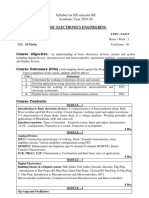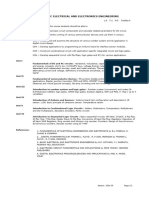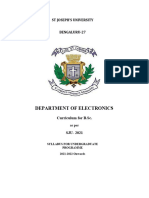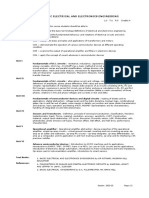FRM Course Syllabus IPDownload
Uploaded by
rishammuhammed6FRM Course Syllabus IPDownload
Uploaded by
rishammuhammed6ECE249:BASIC ELECTRICAL AND ELECTRONICS ENGINEERING
L:3 T:1 P:0 Credits:4
Course Outcomes: Through this course students should be able to
CO1 :: Learn to use basic circuit components and calculate related parameters for DC circuit.
CO2 :: Understand the working of various semiconductor devices and use them in various
applications.
CO3 :: Understand and examine the structure of various number system and its application in
digital circuit design.
CO4 :: Develop applications by programming an Arduino board to interface sensor modules.
CO5 :: Construct combinational circuit with application-specific integrated circuit and logic gates.
CO6 :: Develop sequential circuit with flip-flops, logic gates and IC's for various applications.
Unit I
Fundamentals of DC and AC circuits : resistance, inductance, capacitance, voltage, current, power
and energy concepts, ohm's law, Kirchhoff’s laws, voltage division rule, current division rule,
dependent and independent sources, mesh and nodal analysis, Thevenin’s theorem Norton’s theorem,
alternating current and voltage, definitions of amplitude and phase, average and RMS value of an AC
signal
Unit II
Fundamental of semiconductor devices : PN junction diode(working and characteristics) and its
applications, Bipolar junction transistor (PNP and NPN), MOSFET (types and applications), Op-amp
(features and virtual ground concept), Op-amp (inverting and non-inverting)
Unit III
Introduction to number system and logic gates : Number system (conversion) and codes (B-
G,G-B,Excess-3,BCD), logic gates, CMOS logic gates, boolean algebra, SOP and POS, K- Map ( up to 4
variables)
Unit IV
Introduction of Arduino and Sensors : Arduino board (pin configuration and description), IR
sensor., LDR, basic principle of ultrasonic sensor, Temperature sensor
Unit V
Introduction to Combinational Logic Circuits : Adders, Subtractors, Comparators, Multiplexers
and De-multiplexers, Decoders, Encoders, Parity circuits
Unit VI
Introduction to Sequential Logic Circuits : Basic sequential circuits: SR-latch, D-latch, D flip-flop,
JK flip- flop, T flip-flop, Master Slave JK flip flop, Conversion of basic flip-flop, Registers: Operation of
all basic Shift Registers, Ring counter and Johnson ring counter, Counters: Design of Asynchronous,
Synchronous counters, Decade counter using IC-7490
References:
1. FUNDAMENTALS OF ELECTRICAL ENGINEERING AND ELECTRONICS by B.L.THERAJA, S.
CHAND & COMPANY
2. . DIGITAL FUNDAMENTALS BY THOMAS L. FLOYD , R. P JAIN, PEARSON by THOMAS L.
FLOYD , R. P JAIN, PEARSON
3. BASIC ELECTRICAL AND ELECTRONICS ENGINEERING by D.P. KOTHARI, I J. NAGRATH,
MCGRAW HILL EDUCATION
4. ELECTRONIC CIRCUIT FUNDAMENTALS AND APPLICATIONS by MIKE TOOLEY, NEWNES
PUBLISHERS
5. DIGITAL ELECTRONICS PRINCIPLES,DEVICES AND APPLICATIONS by ANIL K. MAINI,
WILEY
Session 2023-24 Page:1/2
Session 2023-24 Page:2/2
You might also like
- 2 - LOGIC GATES - Revision Worksheet MS - CoachingNo ratings yet2 - LOGIC GATES - Revision Worksheet MS - Coaching22 pages
- Linear Feedback Shift Register v3.0: FeaturesNo ratings yetLinear Feedback Shift Register v3.0: Features19 pages
- Ratioed Logic Design A Fast 6-Input AND Gate in Ea...No ratings yetRatioed Logic Design A Fast 6-Input AND Gate in Ea...4 pages
- Ece249:Basic Electrical and Electronics Engineering: Session 2023-24 Page:1/2100% (1)Ece249:Basic Electrical and Electronics Engineering: Session 2023-24 Page:1/22 pages
- Basic Electric and Electronic EngineeringNo ratings yetBasic Electric and Electronic Engineering2 pages
- Ece249:Basic Electrical and Electronics Engineering: Session 2022-23 Page:1/2No ratings yetEce249:Basic Electrical and Electronics Engineering: Session 2022-23 Page:1/22 pages
- Ece249-Basic Electrical and Electronics EngineeringNo ratings yetEce249-Basic Electrical and Electronics Engineering2 pages
- Electronics UG Syllabus Revised March24No ratings yetElectronics UG Syllabus Revised March2424 pages
- IT Analog and Digital Electronics SyllabusNo ratings yetIT Analog and Digital Electronics Syllabus3 pages
- Graphic Era (Deemed To Be University), Dehradun: Semester I and IiNo ratings yetGraphic Era (Deemed To Be University), Dehradun: Semester I and Ii3 pages
- Ece 131 Basic Electrical and Electronics Engineering SyllabusNo ratings yetEce 131 Basic Electrical and Electronics Engineering Syllabus2 pages
- III Semester: Sl. No. Subject Code Subject CreditsNo ratings yetIII Semester: Sl. No. Subject Code Subject Credits11 pages
- Ece279:Basic Electrical and Electronics Engineering LaboratoryNo ratings yetEce279:Basic Electrical and Electronics Engineering Laboratory2 pages
- Digital Circuits and Systems - I: Course Code: BTEEC 20401 Credit Units: 04 Course ObjectiveNo ratings yetDigital Circuits and Systems - I: Course Code: BTEEC 20401 Credit Units: 04 Course Objective15 pages
- Sir Parshurambhau College, Pune (Autonomous) : Shikshana Prasaraka Mandali'sNo ratings yetSir Parshurambhau College, Pune (Autonomous) : Shikshana Prasaraka Mandali's13 pages
- 0 0ee2203electronic - Devices - Circuits PDFNo ratings yet0 0ee2203electronic - Devices - Circuits PDF4 pages
- Silver Oak University: College of TechnologyNo ratings yetSilver Oak University: College of Technology4 pages
- A Geek Girl's Guide to Electronics and the Internet of ThingsFrom EverandA Geek Girl's Guide to Electronics and the Internet of ThingsNo ratings yet
- Binary Arithmetic and Arithmetic Circuits-2No ratings yetBinary Arithmetic and Arithmetic Circuits-222 pages
- Memory Basics: Emt 235 Digital Electronic Principles 2No ratings yetMemory Basics: Emt 235 Digital Electronic Principles 258 pages
- MICROCONTROLLER-based DC Motor Speed Controller100% (1)MICROCONTROLLER-based DC Motor Speed Controller8 pages
- Automated Water Pump With Dry Run Intimation Using GSM100% (1)Automated Water Pump With Dry Run Intimation Using GSM4 pages
- Finite State Machines (Mealy and Moore Machines) : Gookyi Dennis A. N. Soc Design LabNo ratings yetFinite State Machines (Mealy and Moore Machines) : Gookyi Dennis A. N. Soc Design Lab18 pages
- Flip-Flop Electronics) - Wikipedia, The Free EncyclopedNo ratings yetFlip-Flop Electronics) - Wikipedia, The Free Encycloped16 pages
- Chapter #12: Operational-: Amplifier CircuitsNo ratings yetChapter #12: Operational-: Amplifier Circuits47 pages
- Computer Organization & Architechture CB320No ratings yetComputer Organization & Architechture CB32025 pages
- VLSI Design and ECE: Dr. B. R. Ambedkar National Institute of Technology Jalandhar Dr. Mamta KhoslaNo ratings yetVLSI Design and ECE: Dr. B. R. Ambedkar National Institute of Technology Jalandhar Dr. Mamta Khosla25 pages
- Establishing Qor Flow On Emerging Technology Nodes: Pramod Sripathi Sreenivasa Reddy Kasireddy Raj Sekhar BochkarNo ratings yetEstablishing Qor Flow On Emerging Technology Nodes: Pramod Sripathi Sreenivasa Reddy Kasireddy Raj Sekhar Bochkar33 pages
- 5.3 Combinational PLDS: Programmable Logic ArraysNo ratings yet5.3 Combinational PLDS: Programmable Logic Arrays6 pages
- Cell-Aware ATPG Test Methods Improve Test Quality: A Brief History of IC Test100% (1)Cell-Aware ATPG Test Methods Improve Test Quality: A Brief History of IC Test8 pages

























































































